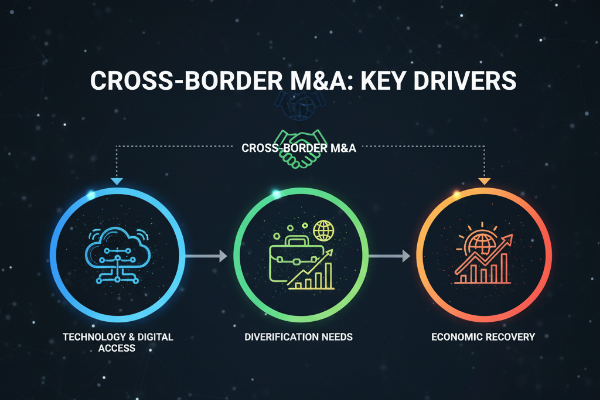
Introduction: Is Your Business Ready for a Global Buyer?
Imagine receiving an offer for your business from an international buyer. The price is attractive, but the complexities of a cross-border deal make you hesitate. Will currency fluctuations affect the payout? How do you navigate foreign regulations? As a business owner, selling your company is one of the biggest decisions you’ll ever make, and the rise of cross-border mergers and acquisitions (M&A) in 2025 is opening new opportunities—and challenges—for sellers like you.
Cross-border M&A deals are surging as global markets become more interconnected. According to recent industry reports, cross-border transactions accounted for nearly 40% of global M&A activity in 2024, a trend that’s expected to grow in 2025. For business owners, this means more potential buyers but also a steeper learning curve. This blog will guide you through the opportunities and challenges of selling to international buyers, offering actionable insights to maximize your sale value while avoiding common pitfalls. Let’s dive into what you need to know to succeed in the global M&A landscape.
Why Cross-Border M&A Is Booming in 2025
Global Market Trends Driving Cross-Border Deals

- Technology & Digital Access (icon: cloud + data)
- Diversification Needs (icon: portfolio or briefcase)
- Economic Recovery (icon: growth arrow or graph)
The global economy is more interconnected than ever, and businesses are looking beyond their borders to grow. Several factors are fuelling the rise of cross-border M&A:
- Technology and Digital Access: Advancements in communication and data-sharing technologies have made it easier for companies to identify and acquire businesses across continents. Virtual due diligence and global deal platforms streamline the process.
- Diversification Needs: International buyers are seeking to diversify their portfolios by entering new markets or acquiring innovative technologies. For example, a European tech firm might target a U.S.-based SaaS company to expand its offerings.
- Economic Recovery: As global economies stabilize post-2024, companies with strong cash reserves are pursuing strategic acquisitions to gain a competitive edge.
Key Opportunities for Sellers in Cross-Border M&A
Access to Premium Valuations
International buyers often have deeper pockets or strategic motivations that drive up valuations. For instance, a buyer from Asia might pay a premium for a U.S.-based manufacturing firm to secure a foothold in North America. To capitalize on this, sellers should:
- Highlight unique value propositions, such as proprietary technology or a loyal customer base.
- Work with an M&A advisor to identify buyers willing to pay a premium for strategic fit.
- Ensure financials are transparent and globally compliant to attract serious offers.
Expanded Buyer Pool
Cross-border M&A opens your business to buyers from regions you might not have considered. A niche software company in the U.S. could attract interest from European or Asian conglomerates looking to diversify. This increased competition can lead to better terms and faster deal closings.
Strategic Legacy Opportunities
Selling to an international buyer can ensure your business thrives in new markets. For example, a U.K.-based retailer acquiring a U.S. fashion brand might expand its reach globally, preserving and growing your brand’s legacy. This can be a key motivator for sellers who care about their company’s long-term impact.
How to Prepare Your Business for a Cross-Border Sale
To maximize your sale value and attract international buyers, preparation is key. Here’s a step-by-step guide:
Step 1: Optimize Your Financials
Buyers will scrutinize your financials, so ensure they’re in order. This includes:
- Audited financial statements for at least the past three years.
- Clear documentation of revenue streams, expenses, and liabilities.
- Compliance with international accounting standards to build trust with global buyers.
Step 2: Strengthen Your Value Proposition
Highlight what makes your business unique. Are you a market leader in a niche industry? Do you have proprietary technology or a loyal customer base? Emphasizing these strengths can attract premium offers from international buyers.
Step 3: Engage an Experienced M&A Advisor
A skilled M&A advisory team can make or break a cross-border deal. Look for M&A advisors with:
- Expertise in your industry and target markets.
- A global network of buyers and industry contacts.
- Experience navigating international regulations and cultural nuances.
Step 4: Plan for Post-Sale Integration
Buyers care about smooth integration. Provide a roadmap covering:
- Staff retention and team transitions.
- Technology transfers and operational alignment.
- Maintaining customer relationships.
Step 5: Be Patient and Flexible
Cross-border deals often take longer than domestic ones due to regulatory approvals and due diligence. Stay patient and be open to negotiating terms that accommodate the buyer’s needs while protecting your interests.
Conclusion: Seize the Global Opportunity with Confidence
The rise of cross-border M&A in 2025 presents a unique opportunity for business owners looking to sell. By understanding the opportunities—like premium valuations and an expanded buyer pool—and preparing for challenges like regulatory hurdles and currency risks, you can position your business for a successful sale.
Partnering with an experienced M&A advisory team is the key to navigating this complex landscape and securing the best possible outcome.Ready to explore a cross-border sale for your business? Our M&A advisory team specializes in helping sellers like you maximize value and close deals with confidence. Contact us today to discuss your goals and start planning your global exit strategy.
